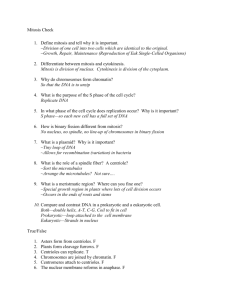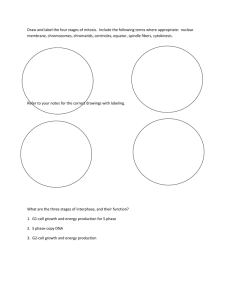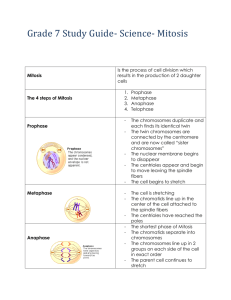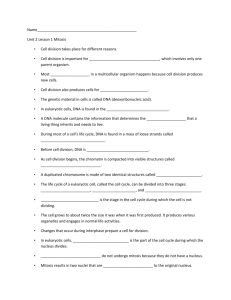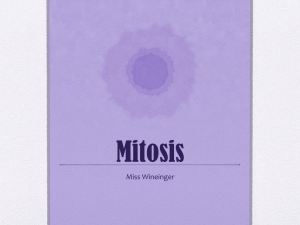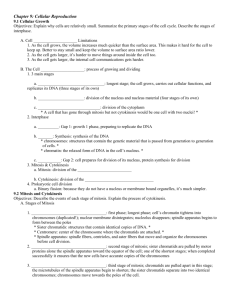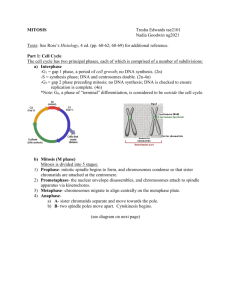CELL CYCLE Chapter 5 – Review
advertisement
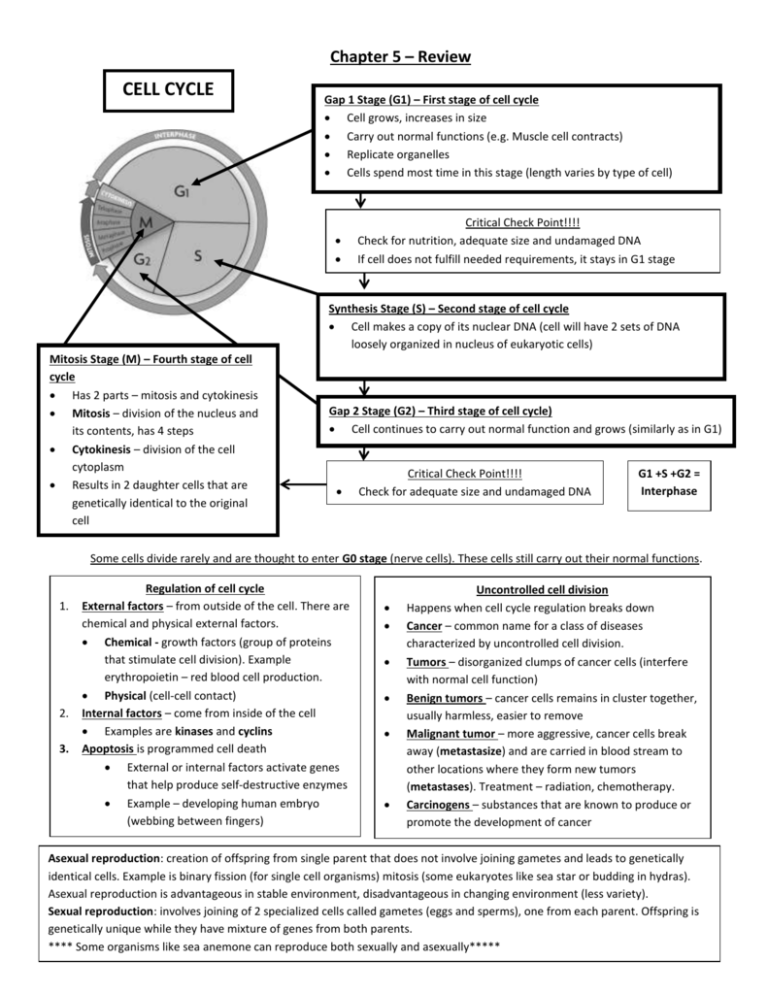
Chapter 5 – Review CELL CYCLE Gap 1 Stage (G1) – First stage of cell cycle Cell grows, increases in size Carry out normal functions (e.g. Muscle cell contracts) Replicate organelles Cells spend most time in this stage (length varies by type of cell) Critical Check Point!!!! Check for nutrition, adequate size and undamaged DNA If cell does not fulfill needed requirements, it stays in G1 stage Synthesis Stage (S) – Second stage of cell cycle Cell makes a copy of its nuclear DNA (cell will have 2 sets of DNA loosely organized in nucleus of eukaryotic cells) Mitosis Stage (M) – Fourth stage of cell cycle Has 2 parts – mitosis and cytokinesis Mitosis – division of the nucleus and its contents, has 4 steps Cytokinesis – division of the cell cytoplasm Results in 2 daughter cells that are genetically identical to the original cell Gap 2 Stage (G2) – Third stage of cell cycle) Cell continues to carry out normal function and grows (similarly as in G1) Critical Check Point!!!! Check for adequate size and undamaged DNA G1 +S +G2 = Interphase Some cells divide rarely and are thought to enter G0 stage (nerve cells). These cells still carry out their normal functions. 1. 2. 3. Regulation of cell cycle External factors – from outside of the cell. There are chemical and physical external factors. Chemical - growth factors (group of proteins that stimulate cell division). Example erythropoietin – red blood cell production. Physical (cell-cell contact) Internal factors – come from inside of the cell Examples are kinases and cyclins Apoptosis is programmed cell death External or internal factors activate genes that help produce self-destructive enzymes Example – developing human embryo (webbing between fingers) Uncontrolled cell division Happens when cell cycle regulation breaks down Cancer – common name for a class of diseases characterized by uncontrolled cell division. Tumors – disorganized clumps of cancer cells (interfere with normal cell function) Benign tumors – cancer cells remains in cluster together, usually harmless, easier to remove Malignant tumor – more aggressive, cancer cells break away (metastasize) and are carried in blood stream to other locations where they form new tumors (metastases). Treatment – radiation, chemotherapy. Carcinogens – substances that are known to produce or promote the development of cancer Asexual reproduction: creation of offspring from single parent that does not involve joining gametes and leads to genetically identical cells. Example is binary fission (for single cell organisms) mitosis (some eukaryotes like sea star or budding in hydras). Asexual reproduction is advantageous in stable environment, disadvantageous in changing environment (less variety). Sexual reproduction: involves joining of 2 specialized cells called gametes (eggs and sperms), one from each parent. Offspring is genetically unique while they have mixture of genes from both parents. **** Some organisms like sea anemone can reproduce both sexually and asexually***** Chromosome (condensed, duplicated) Telomere DNA - one, long, continuous thread of nucleotides (genetic info in nucleus) Chromatin – DNA with histones in loose “spaghetti” form. Cell’s DNA is in this loose form most of the cell cycle (except in mitosis) Chromosome – tightly coiled and condensed form of DNA, visible during mitosis. A chromosome contains numerous genes. In human we have 46 chromosomes. See chromosome structure on the left. Centromere MITOSIS Telomere Chromatid Divides cell nucleus into two genetically identical nuclei (each with 1 set of DNA) Has 4 stages – prophase, metaphase, anaphase and telophase Happens in all cells of our body (except eggs and sperm) Prepares cell for cytokinesis = division of cell cytoplasm (animal cell forms a furrow, plant cell forms a cell plate) Prophase – Stage 1 of mitosis Chromatin condensed into tightly coiled chromosomes Each chromosome = 2 sister chromatids Nuclear envelope breaks down Centrioles move to opposite sides of cell Spindle fibers form Centriole Spindle fibers Metaphase – Stage 2 of mitosis Centriole Spindle fibers attach to each chromosome at centromere Chromosomes align along the cell equator (in the middle) Spindle fibers Nuclear envelope Condensing chromatin Chromosome (2 chromatids joined in centromere) Anaphase – Stage 3 of mitosis Sister chromatids separate from each other Spindle fibers shorten and pull sister chromatids to opposite sides of cell Telophase – Stage 4 of mitosis Nuclear envelope Complete set of identical chromosomes at opposite sides of cell Nuclear envelope starts to form Chromosomes start to uncoil Centriole Spindle fibers fall apart Multicellular life Cells – smallest unit of life Tissues – group of cells that work together to perform a similar function (e.g. muscle tissue) Organs – groups of tissue that work together to perform specific function (e.g. stomach) Organ systems – organs that carry similar functions (e.g. digestive system) Each sister chromatid travels to opposite side of cell Uncoiling chromosomes Breaking spindle fibers Specialization of cells Cell differentiation : process by which unspecialized cells develop into their mature form and function Cells have full set of chromosomes containing genes but use only some genes necessary to live and perform their specific function. (when u cook, you only use specific recipe, not the whole cookbook) Stem cells: unique type of cells that have the ability to: 1. Divide and renew themselves for long periods of time 2. Remain undifferentiated in form 3. Develop into a variety of specialized cell types Adult stem cells - (adult body and in umbilical cord, low in number, great for transplants. Embryonic stem cells – undifferentiated cells from embryo. Both are focus of research!


